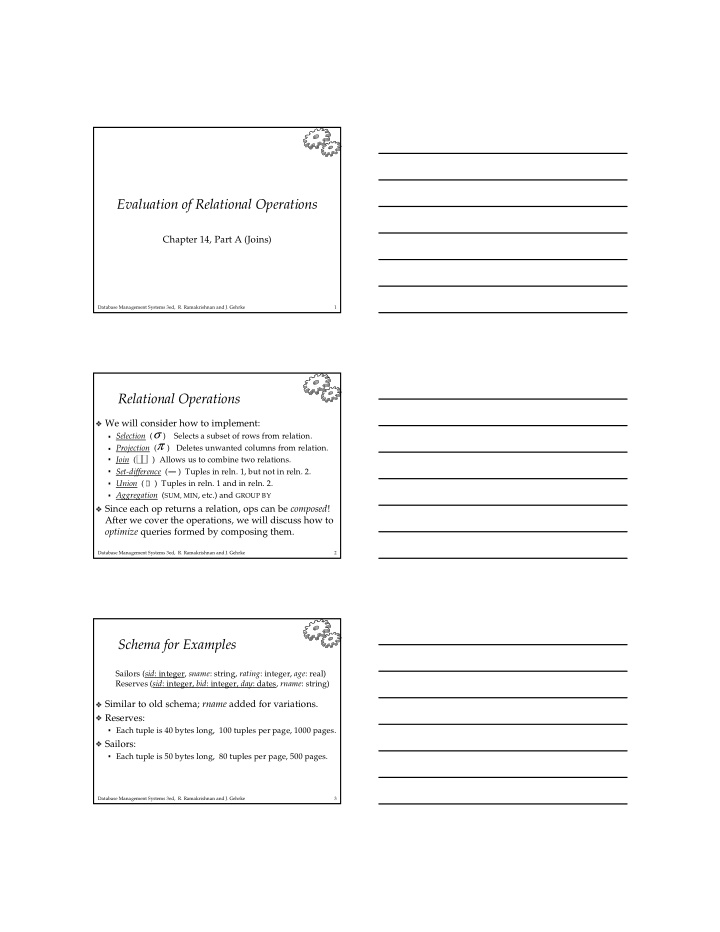



� ✂ � ✁ � ✁ ✁ ✁ ✁ ✁ ✄ � ✄ � ✁ ✁ Evaluation�of�Relational�Operations Chapter�14,�Part�A�(Joins) Database�Management�Systems�3ed,��R. Ramakrishnan and�J.�Gehrke 1 Relational�Operations We�will�consider�how�to�implement: σ Selection (�����)����Selects�a�subset�of�rows�from�relation. π Projection (�����)���Deletes�unwanted�columns�from�relation. Join (��������)��Allows�us�to�combine�two�relations. − Set-difference (�����) Tuples in reln.�1,�but�not�in reln.�2. Union (�����) Tuples in reln.�1�and�in reln.�2. Aggregation ( SUM,�MIN ,�etc.)�and� GROUP�BY Since�each�op�returns�a�relation,�ops�can�be� composed !�� After�we�cover�the�operations,�we�will�discuss�how�to� optimize� queries�formed�by�composing�them. Database�Management�Systems�3ed,��R. Ramakrishnan and�J.�Gehrke 2 Schema�for�Examples Sailors�( sid :�integer, sname :�string,� rating :�integer,� age :�real) Reserves�( sid :�integer,� bid :�integer,� day :�dates, rname :�string) Similar�to�old�schema; rname added�for�variations. Reserves: Each tuple is�40�bytes�long,��100 tuples per�page,�1000�pages. Sailors: Each tuple is�50�bytes�long,��80 tuples per�page,�500�pages.� Database�Management�Systems�3ed,��R. Ramakrishnan and�J.�Gehrke 3
� � ✁ � � ✁ � ✁ � � ✁ ✁ � ✁ � � Equality�Joins�With�One�Join�Column SELECT * Reserves�R1,�Sailors�S1 FROM WHERE R1.sid=S1.sid In�algebra:�R�������S.��Common!��Must�be�carefully� × × optimized.��R������S�is�large;�so,�R�����S�followed�by�a� selection�is�inefficient. Assume:�M tuples in�R, p R tuples per�page,�N tuples in�S, p S tuples per�page. In�our�examples,�R�is�Reserves�and�S�is�Sailors. We�will�consider�more�complex�join�conditions�later. Cost�metric :��#�of�I/Os.��We�will�ignore�output�costs. Database�Management�Systems�3ed,��R. Ramakrishnan and�J.�Gehrke 4 Simple�Nested�Loops�Join foreach�tuple r�in�R�do foreach�tuple s�in�S�do if r i == s j then�add�<r,�s>�to�result For�each tuple in�the� outer relation�R,�we�scan�the� entire� inner relation�S.� Cost:��M�+ p R *�M�*�N��=��1000�+�100*1000*500��I/Os. Page-oriented�Nested�Loops�join:��For�each� page of�R,� get�each� page of�S,�and�write�out�matching�pairs�of tuples <r,�s>,�where�r�is�in�R-page�and�S�is�in�S- page. Cost:��M�+�M*N�=�1000�+�1000*500 If�smaller�relation�(S)�is�outer,�cost�=�500�+�500*1000�� Database�Management�Systems�3ed,��R. Ramakrishnan and�J.�Gehrke 5 Index�Nested�Loops�Join foreach�tuple r�in�R�do foreach�tuple s�in�S�where r i == s j do add�<r,�s>�to�result If�there�is�an�index�on�the�join�column�of�one�relation� (say�S),�can�make�it�the�inner�and�exploit�the�index. Cost:��M�+�(�(M*p R )�*�cost�of�finding�matching�S tuples)� For�each�R tuple,�cost�of�probing�S�index�is�about�1.2� for�hash�index,�2-4�for�B+�tree.��Cost�of�then�finding�S tuples (assuming�Alt.�(2)�or�(3)�for�data�entries)� depends�on�clustering. Clustered�index:��1�I/O�(typical), unclustered: upto 1�I/O� per�matching�S tuple. Database�Management�Systems�3ed,��R. Ramakrishnan and�J.�Gehrke 6
� ✂ ✄ ✄ ✄ ✁ ✁ � ✂ ✂ ✄ ✂ ✂ ✁ ✁ ✁ ✁ ✁ ✁ ✄ ✄ ✁ ✆ � ✁ ✁ ✁ � ✆ ✆ ✆ ☎ ✄ ☎ ☎ ☎ ☎ ☎ ☎ ☎ ✄ ✁ ✁ ✁ � ✁ ✁ ✞ ✝ ✁ � ✁ � ✁ ✁ � � � � � � � � � � Examples�of�Index�Nested�Loops Hash-index�(Alt.�2)�on sid of�Sailors�(as�inner): Scan�Reserves:��1000�page�I/Os,�100*1000 tuples. For�each�Reserves tuple:��1.2�I/Os�to�get�data�entry�in� index,�plus�1�I/O�to�get�(the�exactly�one)�matching�Sailors tuple.��Total:��220,000�I/Os. Hash-index�(Alt.�2)�on sid of�Reserves�(as�inner): Scan�Sailors:��500�page�I/Os,�80*500 tuples. For�each�Sailors tuple:��1.2�I/Os�to�find�index�page�with� data�entries,�plus�cost�of�retrieving�matching�Reserves tuples.��Assuming�uniform�distribution,�2.5�reservations� per�sailor�(100,000�/�40,000).��Cost�of�retrieving�them��is�1�or 2.5�I/Os�depending�on�whether�the�index�is�clustered. Database�Management�Systems�3ed,��R. Ramakrishnan and�J.�Gehrke 7 Block�Nested�Loops�Join Use�one�page�as�an�input�buffer�for�scanning�the� inner�S,�one�page�as�the�output�buffer,�and�use�all� remaining�pages�to�hold�``block’’�of�outer�R. For�each�matching tuple r�in�R-block,�s�in�S-page,�add������ <r,�s>�to�result.��Then�read�next�R-block,�scan�S,�etc. R�&�S Join�Result Hash�table�for�block�of�R (k�<�B-1�pages) .�.�. .�.�. .�.�. Input�buffer�for�S Output�buffer Database�Management�Systems�3ed,��R. Ramakrishnan and�J.�Gehrke 8 Examples�of�Block�Nested�Loops Cost:��Scan�of�outer�+��#outer�blocks�*�scan�of�inner # / of pages of outer blocksize #outer�blocks�= With�Reserves�(R)�as�outer,�and�100�pages�of�R: Cost�of�scanning�R�is�1000�I/Os;��a�total�of�10� blocks . Per�block�of�R,�we�scan�Sailors�(S);��10*500�I/Os. If�space�for�just�90�pages�of�R,�we�would�scan�S�12�times. With�100-page�block�of�Sailors�as�outer: Cost�of�scanning�S�is�500�I/Os;�a�total�of�5�blocks. Per�block�of�S,�we�scan�Reserves;���5*1000�I/Os. With� sequential�reads considered,�analysis�changes:�� may�be�best�to�divide�buffers�evenly�between�R�and�S. Database�Management�Systems�3ed,��R. Ramakrishnan and�J.�Gehrke 9
✁ ✁ ✁ ✁ � � ✁ � � � � � ✁ ✁ � ✁ Sort-Merge�Join��(R�����S) i=j Sort�R�and�S�on�the�join�column,�then�scan�them�to�do� a�``merge’’�(on�join�col.),�and�output�result tuples. Advance�scan�of�R�until�current�R-tuple >=�current�S tuple,� then�advance�scan�of�S�until�current�S-tuple >=�current�R tuple;�do�this�until�current�R tuple =�current�S tuple. At�this�point,�all�R tuples with�same�value�in Ri ( current�R� group )�and�all�S tuples with�same�value�in Sj ( current�S� group )� match ;��output�<r,�s>�for�all�pairs�of�such tuples. Then�resume�scanning�R�and�S. R�is�scanned�once;�each�S�group�is�scanned�once�per� matching�R tuple.��(Multiple�scans�of�an�S�group�are� likely�to�find�needed�pages�in�buffer.) Database�Management�Systems�3ed,��R. Ramakrishnan and�J.�Gehrke 10 Example�of�Sort-Merge�Join sid bid day rname 28 103 12/4/96 guppy sid sname rating age 28 103 11/3/96 yuppy 22 dustin 7 45.0 31 101 10/10/96 dustin 28 yuppy 9 35.0 31 102 10/12/96 lubber 31 lubber 8 55.5 31 101 10/11/96 lubber 44 guppy 5 35.0 58 103 11/12/96 dustin 58 rusty 10 35.0 Cost:��M�log�M�+�N�log�N�+�(M+N) The�cost�of�scanning,�M+N,�could�be�M*N�(very�unlikely!) With�35,�100�or�300�buffer�pages,�both�Reserves�and� Sailors�can�be�sorted�in�2�passes;�total�join�cost:�7500.� ( BNL�cost:��2500�to�15000�I/Os ) Database�Management�Systems�3ed,��R. Ramakrishnan and�J.�Gehrke 11 Refinement�of�Sort-Merge�Join We�can�combine�the�merging�phases�in�the� sorting of� R�and�S�with�the�merging�required�for�the�join. L With�B�>�������,�where� L� is�the�size�of�the�larger�relation,�using� the�sorting�refinement�that�produces�runs�of�length�2B�in� Pass�0,�#runs�of�each�relation�is�<�B/2. Allocate�1�page�per�run�of�each�relation,�and�`merge’�while� checking�the�join�condition. Cost:��read+write�each�relation�in�Pass�0�+�read�each�relation� in�(only)�merging�pass��(+�writing�of�result tuples). In�example,�cost�goes�down�from�7500�to�4500�I/Os. In�practice,�cost�of�sort-merge�join,�like�the�cost�of� external�sorting,�is� linear . Database�Management�Systems�3ed,��R. Ramakrishnan and�J.�Gehrke 12
Recommend
More recommend